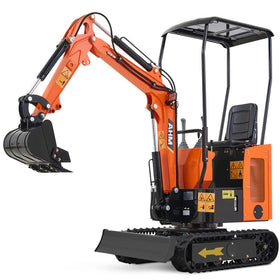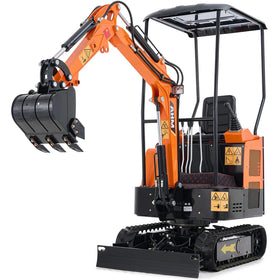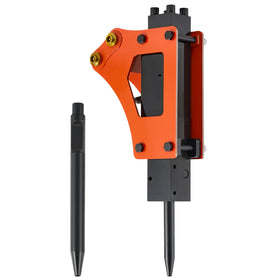Mini excavators offer incredible versatility for construction, landscaping, and property maintenance. But choosing the wrong size can cost you time, money, and frustration. This guide will help you understand mini excavator sizes and select the perfect machine for your specific needs.
Mini Excavator Size Categories
Mini excavators range from tiny 1-ton machines to hefty 10-ton models. Each weight class serves different purposes and offers distinct advantages.
| Size Category | Weight Range | Typical Dig Depth | Best For |
|---|---|---|---|
| Micro | 1-2 tons | 5-7 feet | Tight indoor spaces, backyard projects |
| Compact | 3-4 tons | 8-10 feet | Residential work, utilities, landscaping |
| Mid | 5-6 tons | 11-13 feet | Light commercial, foundation work |
| Standard Mini | 7-10 tons | 14-16 feet | Commercial projects, deeper excavation |
The Environmental Protection Agency (EPA) notes that smaller machines generally have lower emissions: "Smaller nonroad equipment like mini excavators typically consume less fuel and produce fewer emissions than their larger counterparts when performing appropriately-sized tasks."
Key Factors That Determine What Size You Need
1. Dig Depth Requirements
The most important specification for any excavator is how deep it can dig. Mini excavators typically range from 5 to 16 feet in digging depth.
Ask yourself: "What's the deepest hole I'll need to dig?"
For most residential projects like drainage ditches or small footings, a 2.5ton mini excavator with 8-10 feet of dig depth works well. If you're installing septic tanks or deeper foundations, you'll need a 6+ ton model.
Further Reading: How Deep Can a Mini Excavator Dig?
2. Work Space Constraints
One of the biggest advantages of mini excavators is their ability to work in tight spaces. When measuring your work area, consider:
- Width of access points (gates, doors, between buildings)
- Working radius needed for the machine to turn and operate
- Overhead clearance for the boom and arm
The smallest mini excavators can fit through standard doorways (36 inches), while larger models may require 5+ feet of clearance.
Further Reading: How To Operate Mini Excavator in Tight Spaces
3. Lifting Capacity
Mini excavators aren't just for digging—they also lift materials. Lifting capacity increases with machine size:
- 1-2 ton machines: 500-1,000 lbs
- 3-4 ton machines: 1,500-2,500 lbs
- 5-6 ton machines: 3,000-4,000 lbs
- 7-10 ton machines: 4,500-7,500 lbs
For landscaping with heavy materials like boulders or concrete, you should always remember that lifting capacity decreases as the arm extends outward.
Further Reading: How Much Weight Can a Mini Excavator Lift?
4. Transportation Requirements
How you'll move the excavator between job sites is critical in your decision. Most pickup trucks can only safely tow up to 5,000-7,500 pounds.
A 1-2 ton mini excavator can often be transported on a standard utility trailer behind a half-ton pickup. For machines above 4 tons, you'll typically need a dedicated equipment trailer and possibly a larger truck.
According to the U.S. Department of Transportation, "Always ensure your towing setup is rated to handle the combined weight of the equipment and trailer, and that proper tie-down procedures are followed for safe transport."
Common Projects and Recommended Sizes
Residential Landscaping
For most home landscaping work including gardens, small ponds, and drainage:
- Recommended size: 1.1-3 ton
- Why: Offers good balance between power and minimal lawn damage
- Key benefit: Can access most backyard areas while providing adequate digging depth for most landscaping needs
Utility Trenching
For digging trenches for water, gas, or electrical lines:
- Recommended size: 1.1-4 ton
- Why: Provides necessary depth (typically 8-10 feet) while remaining relatively easy to transport
- Key benefit: Narrow bucket options available for clean, precise trenches
Foundation Work
For excavating foundations or basement work:
- Recommended size: 2.5-7 ton
- Why: Provides deeper digging capability and better lifting capacity for removing large amounts of soil
- Key benefit: More stability and power for consistent, heavy-duty digging
Commercial Construction
For serious construction projects with significant earth moving:
- Recommended size: 7-10 ton
- Why: Maximum digging depth and power in the mini excavator category
- Key benefit: Productivity approaches that of full-sized excavators while maintaining some maneuverability advantages
Special Features That Affect Size Choice
Zero Tail Swing vs. Conventional
Zero tail swing models have a counterweight that doesn't extend beyond the tracks when rotating. This feature is valuable in tight spaces but often requires a slightly larger machine to maintain the same performance.
For working near walls, fences, or in confined areas, prioritize zero tail swing. For open areas where space isn't limited, conventional tail swing models typically offer more stability and slightly better performance for the size.
Adjustable Tracks
Some mini excavators come with expandable/retractable tracks. These machines can narrow to fit through gates or doorways, then widen for better stability during operation.
This feature is particularly valuable if you frequently work in areas with narrow access points but need stability once you're in the working area.
Renting vs. Buying Considerations
If you're unsure about what size you need, renting different models can provide hands-on experience. Many contractors recommend renting a machine for your first few projects to determine what size best suits your typical work.
Rental costs typically range from:
- 1-2 ton: $200-300/day
- 3-4 ton: $250-350/day
- 5-6 ton: $300-450/day
- 7-10 ton: $400-600/day
For occasional use, renting makes more sense. If you'll use the machine more than 40-50 days per year, purchasing becomes more economical in the long run.
Operation Skill Requirements
Larger mini excavators require more skill to operate effectively. While all sizes use similar controls, the increased power, weight, and capabilities of larger machines demand more precision and experience.
If you're new to operating excavators, starting with a smaller model (1-3 ton) provides a gentler learning curve while still accomplishing many tasks.
Common Questions About Mini Excavator Size
1. What size mini excavator do I need for digging fence post holes?
For standard fence post holes, a 1.5-2 ton mini excavator with an auger attachment is ideal. This size provides enough power for the auger while being small enough to maneuver between posts without causing excessive ground damage.
2. Can a mini excavator remove tree stumps?
Yes, but size requirements depend on the stump diameter. For stumps up to 12 inches, a 3-ton machine typically works well. Larger stumps may require 5+ ton machines. Using a thumb attachment greatly improves stump removal capability.
3. What size excavator do I need for a small pond?
For a backyard pond (10-15 feet across, 2-3 feet deep), a 2-3 ton mini excavator works well. For larger ponds or those requiring deeper excavation, consider a 4-6 ton machine.
4. How much space do I need to operate a mini excavator?
As a general rule, you need a working area at least twice the length of the excavator, plus room for the fully extended arm and bucket. For a typical 3-ton machine, plan for at least 15-20 feet of working radius.
Conclusion
When choosing a mini excavator size, always start by identifying your most demanding regular task:
- Ask yourself what are your specific requirements for dig depth, lifting capacity, and operating environment
- Then select a mini excavator that comfortably handles that work.
If you only occasionally need larger capacity, it's often more economical to rent a bigger machine for those specific jobs.
Bigger isn't always better—the right-sized machine for your needs will be more fuel-efficient, cause less property damage, and potentially cost less to transport and maintain.







